2016 HONDA CIVIC COUPE fuel pressure
[x] Cancel search: fuel pressurePage 12 of 585
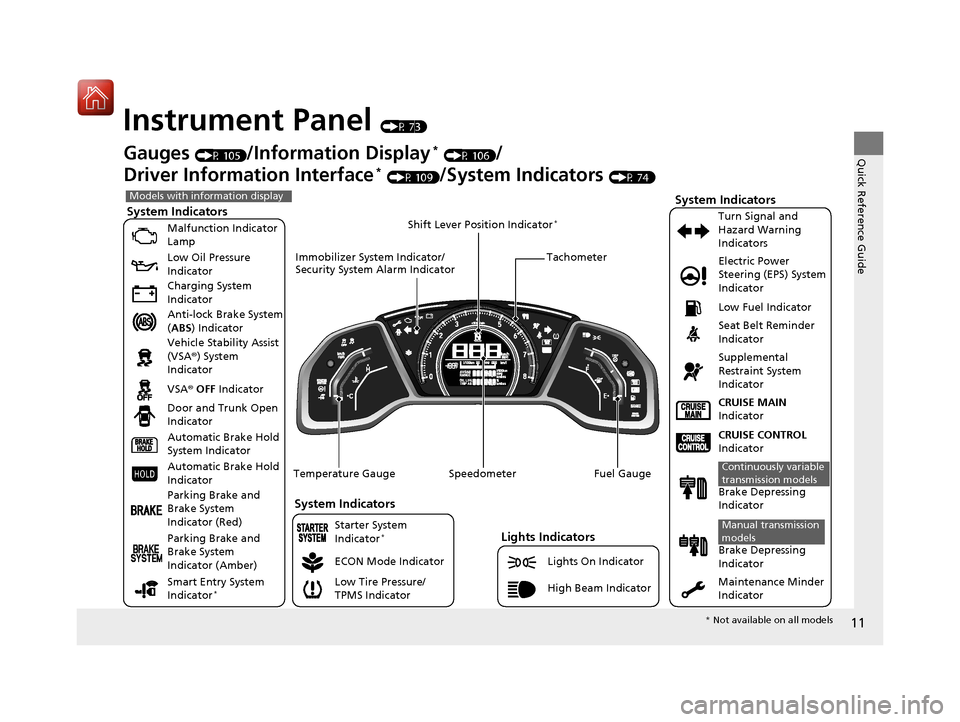
11
Quick Reference Guide
Instrument Panel (P 73)
System Indicators
Malfunction Indicator Lamp Low Oil Pressure
Indicator
Charging System
Indicator
Anti-lock Brake System (ABS ) Indicator
Vehicle Stability Assist
(VSA ®) System
Indicator VSA ® OFF Indicator
Low Tire Pressure/
TPMS Indicator Electric Power
Steering (EPS) System
Indicator
Lights Indicators Lights On Indicator
High Beam Indicator Seat Belt Reminder
Indicator
System Indicators
CRUISE CONTROL
Indicator
Parking Brake and
Brake System
Indicator (Red) Supplemental
Restraint System
Indicator
Door and Trunk Open
Indicator CRUISE MAIN
Indicator
Tachometer
Speedometer Fuel Gauge
Immobilizer System Indicator/
Security System Alarm Indicator
Shift Lever Position Indicator
*
Low Fuel Indicator
Gauges
(P 105)/Information Display *
(P 106) /
Driver Information Interface *
(P 109) /System Indicators (P 74)
ECON Mode Indicator Turn Signal and
Hazard Warning
Indicators
Maintenance Minder
Indicator
Models with info
rmation display
Parking Brake and
Brake System
Indicator (Amber) System Indicators
Automatic Brake Hold
System Indicator
Automatic Brake Hold
Indicator
Temperature Gauge
Brake Depressing
Indicator
Continuously variable
transmission models
Brake Depressing
Indicator
Manual transmission
models
Smart Entry System
Indicator
*
Starter System
Indicator
*
*
Not available on all models
16 CIVIC 2D HC2 (0A 01 0C)-31TBG6000.book 11 ページ >0>.>/6年>0月>/>0日 金 曜日 午後4時>/6分
Page 13 of 585
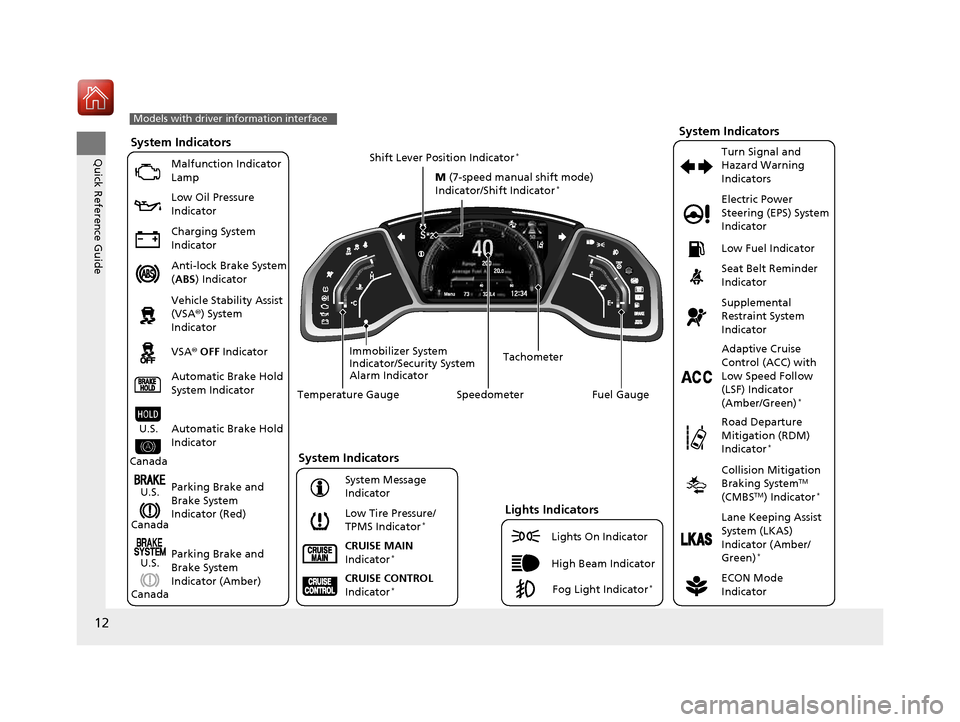
12
Quick Reference GuideSystem IndicatorsMalfunction Indicator Lamp Low Oil Pressure
Indicator
Charging System
Indicator
Anti-lock Brake System (ABS ) Indicator
Vehicle Stability Assist
(VSA ®) System
Indicator VSA ® OFF Indicator
Low Tire Pressure/
TPMS Indicator* Electric Power
Steering (EPS) System
Indicator
Seat Belt Reminder
Indicator
System Indicators
Parking Brake and
Brake System
Indicator (Red) Supplemental
Restraint System
Indicator
Tachometer
Speedometer Fuel Gauge
Immobilizer System
Indicator/Security System
Alarm Indicator Shift Lever Position Indicator
*
Low Fuel Indicator
ECON Mode
Indicator
Turn Signal and
Hazard Warning
Indicators
Models with driver information interface
Parking Brake and
Brake System
Indicator (Amber)
System Indicators
U.S.
Canada
U.S.
Canada Automatic Brake Hold
System Indicator
Automatic Brake Hold
IndicatorU.S.
Canada Temperature Gauge
Lights Indicators
Lights On Indicator
High Beam Indicator
Fog Light Indicator *Adaptive Cruise
Control (ACC) with
Low Speed Follow
(LSF) Indicator
(Amber/Green)
*
System Message
Indicator Collision Mitigation
Braking System
TM
(CMBS TM
) Indicator *
Road Departure Mitigation (RDM)
Indicator*
Lane Keeping Assist
System (LKAS)
Indicator (Amber/
Green)*
CRUISE CONTROL
Indicator *
CRUISE MAIN
Indicator *M
(7-speed manual shift mode)
Indicator/Shift Indicator *
16 CIVIC 2D HC2 (0A 01 0C)-31TBG6000.book 12 ページ >0>.>/6年>0月>/>0日 金
曜日 午後4時>/6分
Page 113 of 585

uuGauges and DisplaysuDriver Information Interface*
112
Instrument Panel
Shows the outside temperature in Fahr enheit (U.S.) or Celsius (Canada).
■ Adjusting the outside temperature display
Adjust the temperature reading up to ±5°F or ±3°C if the temperature reading
seems incorrect.
Use the driver information interface’s customized features to correct the
temperature. 2 Customized Features P. 292
Shows the instant fuel economy as a bar graph in mpg or l/100 km.
When the turbo charger is activated, this
meter shows the boost pressure.
Shows you turn-by-turn driving directions to your destination linked with the
navigation system. 2 Refer to the Navigation System Manual
■Outside Temperature
■Instant Fuel Economy
■Turbo Meter *
1Outside Temperature
The temperature sensor is in the front bumper.
Road heat and exhaust from another vehicle can
affect the temperature reading when your vehicle
speed is less than 19 mph (30 km/h).
It may take several minutes for the display to be
updated after the temperature reading has stabilized.
■Turn-by-Turn Directions
*1Turn-by-Turn Directions
*
You can select whether th e turn-by-turn display
comes on during the route guidance. 2 Customized Features P. 292
* Not available on all models
16 CIVIC 2D HC2 (0A 01 0C)-31TBG6000.book 112 ページ >0>.>/6年>0月>/>0日 金曜日 午後4時>/6分
Page 380 of 585
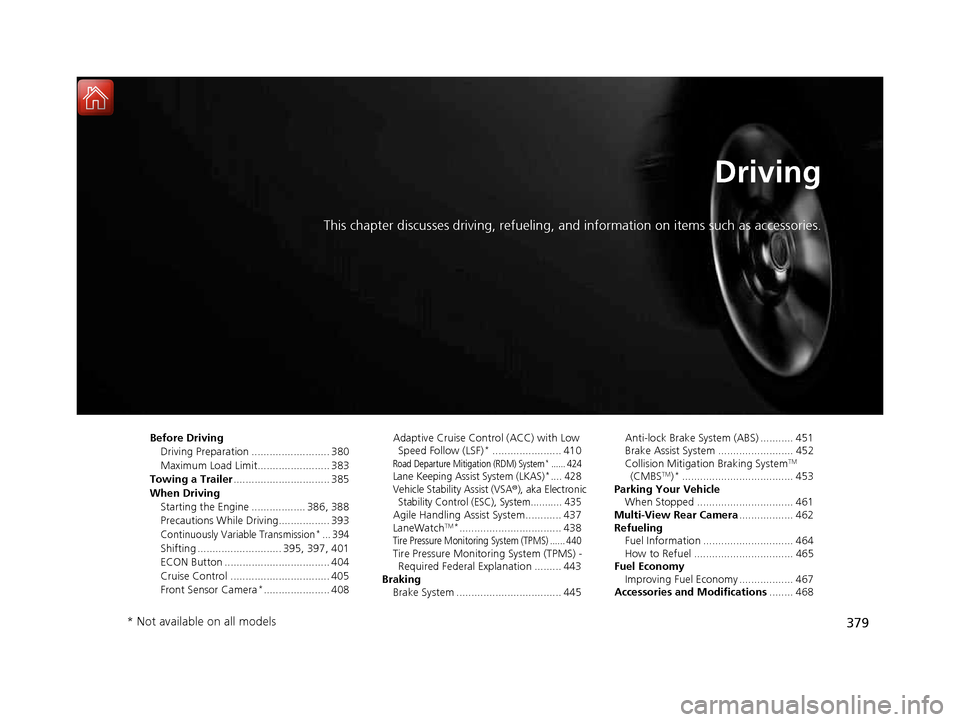
379
Driving
This chapter discusses driving, refueling, and information on items such as accessories.
Before Driving
Driving Preparation .......................... 380
Maximum Load Limit........................ 383
Towing a Trailer ................................ 385
When Driving Starting the Engine .................. 386, 388
Precautions While Driving................. 393
Continuously Variable Transmission*... 394
Shifting ............................ 395, 397, 401
ECON Button ................................... 404
Cruise Control ................................. 405Front Sensor Camera *
...................... 408 Adaptive Cruise Control (ACC) with Low
Speed Follow (LSF) *
....................... 410
Road Departure Mitigation (RDM) System*...... 424Lane Keeping Assist System (LKAS)*.... 428
Vehicle Stabilit y Assist (VSA®), aka Electronic
Stability Control (ESC), System........... 435
Agile Handling Assist System............ 437
LaneWatch TM
*
.................................. 438
Tire Pressure Monitoring System (TPMS) ...... 440Tire Pressure Monitoring System (TPMS) -
Required Federal Explanation ......... 443
Braking
Brake System ................................... 445 Anti-lock Brake System (ABS) ........... 451
Brake Assist System ......................... 452
Collision Mitigation Braking System
TM
(CMBS TM
)*
..................................... 453
Parking Your Vehicle When Stopped ................................ 461
Multi-View Rear Camera .................. 462
Refueling
Fuel Information .............................. 464
How to Refuel ................................. 465
Fuel Economy
Improving Fuel Economy .................. 467
Accessories and Modifications ........ 468
* Not available on all models
16 CIVIC 2D HC2 (0A 01 0C)-31TBG6000.book 379 ページ >0>.>/6年>0月>/>0日 金曜日 午後4時>/6分
Page 444 of 585
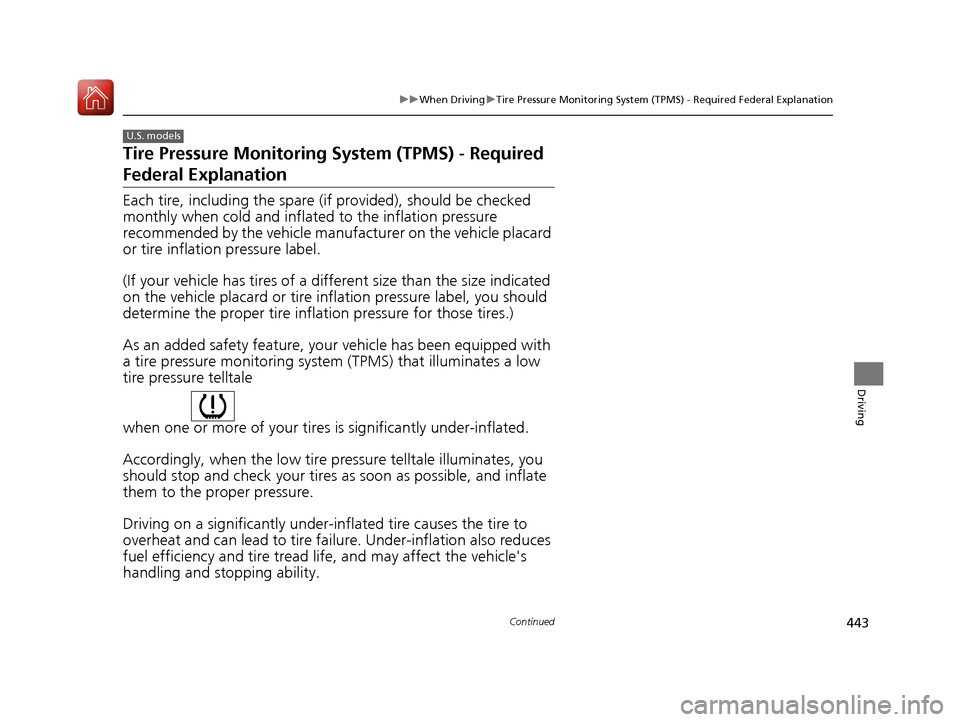
443
uuWhen DrivinguTire Pressure Monitoring System (TPMS) - Required Federal Explanation
Continued
Driving
Tire Pressure Monitoring System (TPMS) - Required
Federal Explanation
Each tire, including the spare (if provided), should be checked
monthly when cold and inflated to the inflation pressure
recommended by the vehicle manufa cturer on the vehicle placard
or tire inflation pressure label.
(If your vehicle has tires of a diff erent size than the size indicated
on the vehicle placard or tire inflation pressure label, you should
determine the proper tire inflat ion pressure for those tires.)
As an added safety feature, your vehicle has been equipped with
a tire pressure monitoring system (TPMS) that illuminates a low
tire pressure telltale
when one or more of your tires is significantly under-inflated.
Accordingly, when the low tire pressure telltale illuminates, you
should stop and check your tires as soon as possible, and inflate
them to the proper pressure.
Driving on a significantly under-inf lated tire causes the tire to
overheat and can lead to tire fail ure. Under-inflation also reduces
fuel efficiency and tire tread life, and may affect the vehicle's
handling and stopping ability.
U.S. models
16 CIVIC 2D HC2 (0A 01 0C)-31TBG6000.book 443 ページ >0>.>/6年>0月>/>0日 金曜日 午後4時>/6分
Page 468 of 585
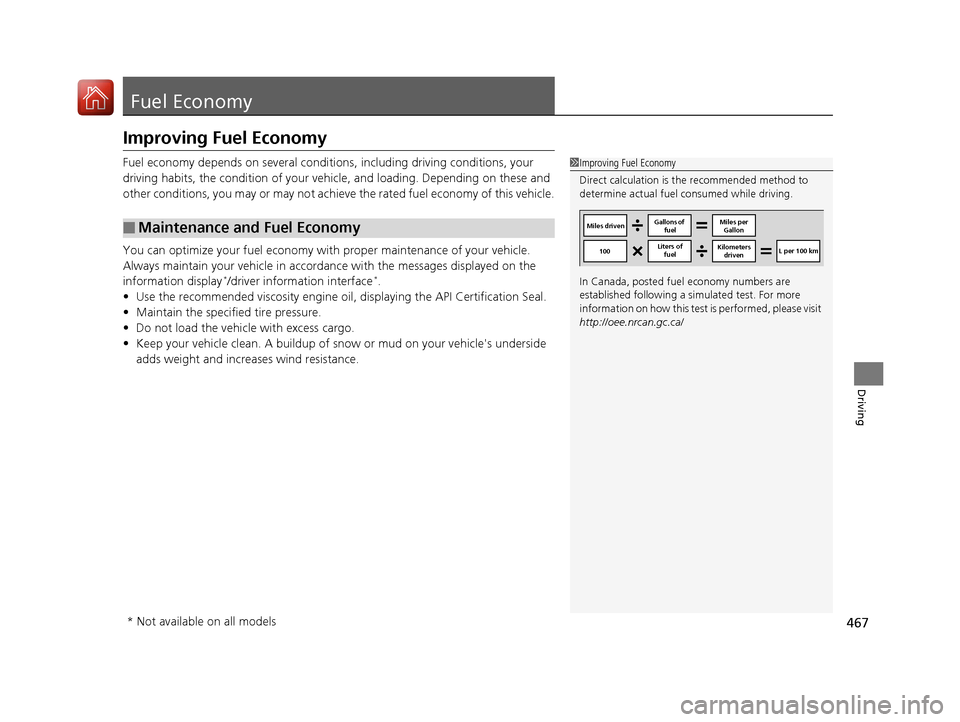
467
Driving
Fuel Economy
Improving Fuel Economy
Fuel economy depends on several conditions, including driving conditions, your
driving habits, the condition of your vehicle, and loading. Depending on these and
other conditions, you may or may not achieve the rated fuel economy of this vehicle.
You can optimize your fuel economy with proper maintenance of your vehicle.
Always maintain your vehicle in accordance with the messages displayed on the
information display *
/driver information interface *
.
• Use the recommended viscosity engine oil, displaying the API Certification Seal.
• Maintain the specified tire pressure.
• Do not load the vehicle with excess cargo.
• Keep your vehicle clean. A buildup of snow or mud on your vehicle's underside adds weight and increases wind resistance.
■Maintenance and Fuel Economy
1Improving Fuel Economy
Direct calculation is the recommended method to
determine actual fuel consumed while driving.
In Canada, posted fuel economy numbers are
established following a simulated test. For more
information on how this test is performed, please visit
http://oee.nrcan.gc.ca/
Miles driven Gallons of
fuel Miles per
Gallon
100 Liters of
fuel Kilometers
driven L per 100 km
* Not available on all models
16 CIVIC 2D HC2 (0A 01 0C)-31TBG6000.book 467 ページ >0>.>/6年>0月>/>0日
金曜日 午後4時>/6分
Page 471 of 585
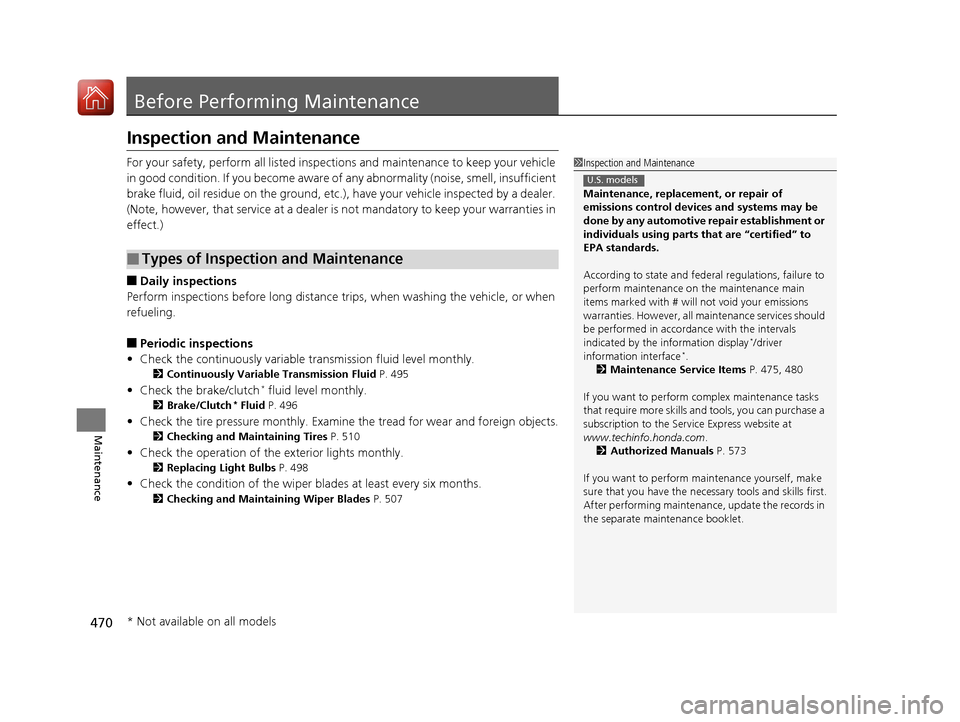
470
Maintenance
Before Performing Maintenance
Inspection and Maintenance
For your safety, perform all listed inspections and maintenance to keep your vehicle
in good condition. If you become aware of any abnormality (noise, smell, insufficient
brake fluid, oil residue on the ground, etc.), have your vehicle inspected by a dealer. (Note, however, that service at a dealer is not mandatory to keep your warranties in
effect.) ■ Daily inspections
Perform inspections before long distance tri ps, when washing the vehicle, or when
refueling. ■ Periodic inspections
• Check the continuously variable transmission fluid level monthly.
2 Continuously Variable Transmission Fluid P. 495
• Check the brake/clutch *
fluid level monthly.
2 Brake/Clutch *
Fluid P. 496
• Check the tire pressure monthly. Examin e the tread for wear and foreign objects.
2 Checking and Maintaining Tires P. 510
• Check the operation of the exterior lights monthly.
2 Replacing Light Bulbs P. 498
• Check the condition of the wiper bl ades at least every six months.
2 Checking and Maintaining Wiper Blades P. 507
■Types of Inspection and Maintenance
1Inspection and Maintenance
Maintenance, replacement, or repair of
emissions control devices and systems may be
done by any automotive repair establishment or
individuals using parts that are “certified” to
EPA standards.
According to state and federal regulations, failure to
perform maintenance on the maintenance main
items marked with # will not void your emissions
warranties. However, all ma intenance services should
be performed in accordan ce with the intervals
indicated by the information display *
/driver
information interface *
.
2 Maintenance Service Items P. 475, 480
If you want to perform complex maintenance tasks
that require more skills a nd tools, you can purchase a
subscription to the Service Express website at
www.techinfo.honda.com .
2 Authorized Manuals P. 573
If you want to perform ma intenance yourself, make
sure that you have the necessary tools and skills first.
After performing ma intenance, update the records in
the separate maintenance booklet.
U.S. models
* Not available on all models
16 CIVIC 2D HC2 (0A 01 0C)-31TBG6000.book 470 ページ >0>.>/6年>0月>/>0日 金曜日 午後4時>/6分
Page 511 of 585
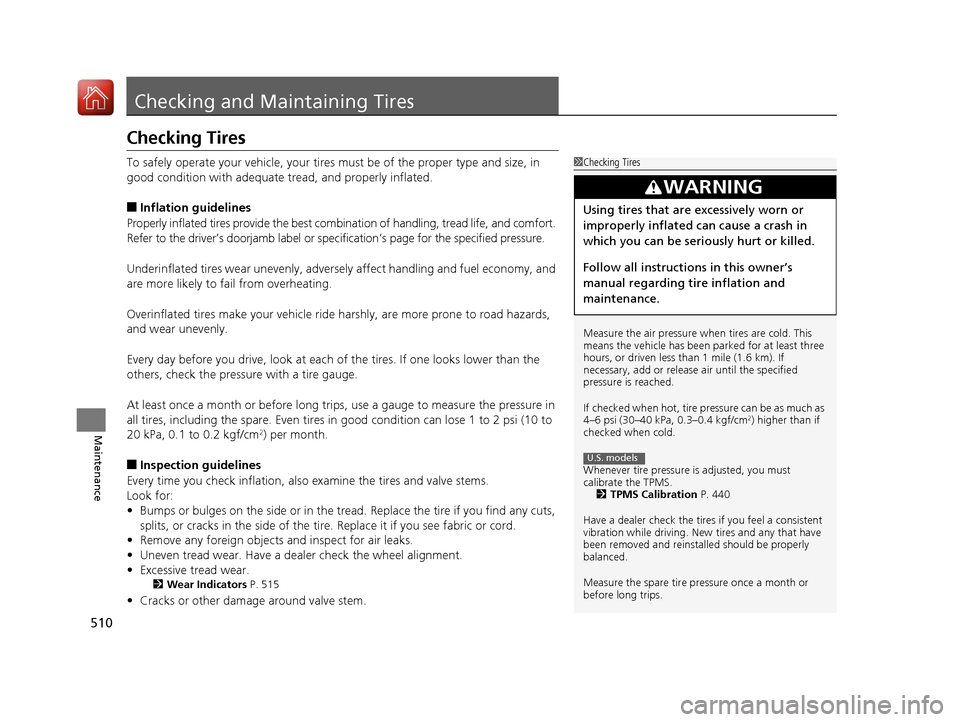
510
Maintenance
Checking and Maintaining Tires
Checking Tires
To safely operate your vehicle, your tires must be of the proper type and size, in
good condition with adequate tread, and properly inflated. ■Inflation guidelines
Properly inflated tires provide the best combination of handling, tread life, and comfort.
Refer to the driver’s doorjamb label or spec ification’s page for the specified pressure.
Underinflated tires wear unevenly, adversely affect handling and fuel economy, and
are more likely to fail from overheating.
Overinflated tires make your vehicle ride harshly, are more prone to road hazards,
and wear unevenly.
Every day before you drive, look at each of the tires. If one looks lower than the
others, check the pressure with a tire gauge.
At least once a month or before long trips, use a gauge to measure the pressure in
all tires, including the spare. Even tires in good condition can lose 1 to 2 psi (10 to
20 kPa, 0.1 to 0.2 kgf/cm 2
) per month.
■ Inspection guidelines
Every time you check inflation, also examine the tires and valve stems.
Look for:• Bumps or bulges on the side or in the tread. Replace the tire if you find any cuts,
splits, or cracks in the si de of the tire. Replace it if you see fabric or cord.
• Remove any foreign objects and inspect for air leaks.
• Uneven tread wear. Have a deal er check the wheel alignment.
• Excessive tread wear.
2 Wear Indicators P. 515
• Cracks or other damage around valve stem.
1Checking Tires
Measure the air pressure when tires are cold. This
means the vehicle has been parked for at least three
hours, or driven less than 1 mile (1.6 km). If necessary, add or releas e air until the specified
pressure is reached.
If checked when hot, tire pressure can be as much as
4–6 psi (30–40 kPa, 0.3–0.4 kgf/cm 2
) higher than if
checked when cold.
Whenever tire pressure is adjusted, you must
calibrate the TPMS. 2 TPMS Calibration P. 440
Have a dealer check the tires if you feel a consistent
vibration while driving. Ne w tires and any that have
been removed and reinst alled should be properly
balanced.
Measure the spare tire pressure once a month or before long trips.
3WARNING
Using tires that are excessively worn or
improperly inflated can cause a crash in
which you can be seriously hurt or killed.
Follow all instruction s in this owner’s
manual regarding ti re inflation and
maintenance.
U.S. models
16 CIVIC 2D HC2 (0A 01 0C)-31TBG6000.book 510 ページ >0>.>/6年>0月>/>0日 金曜日 午後4時>/6分